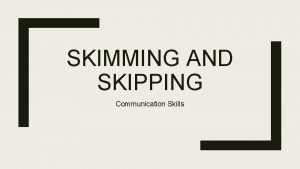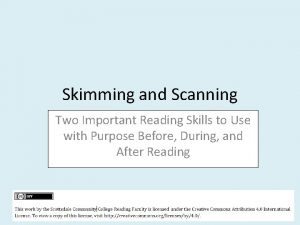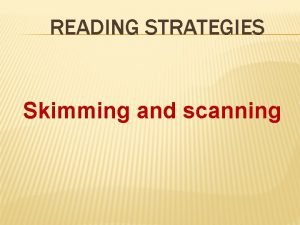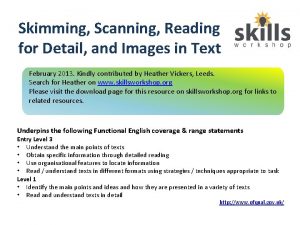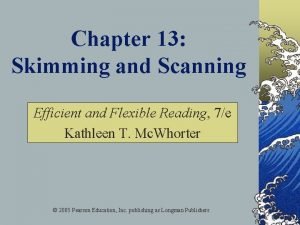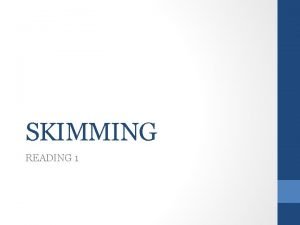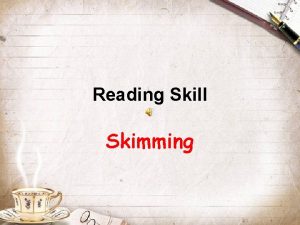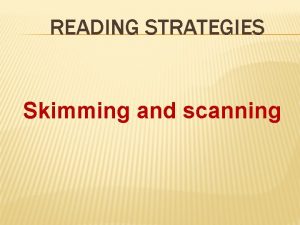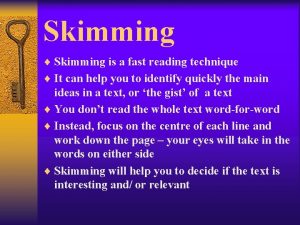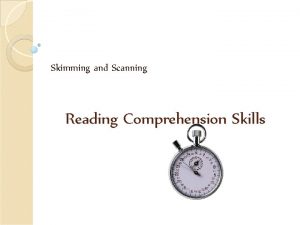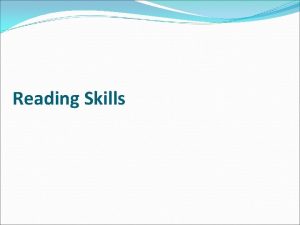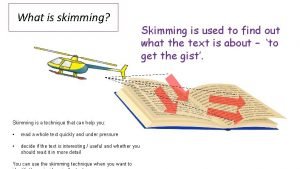SKIMMING READING 1 What is skimming Skimming is









- Slides: 9

SKIMMING READING 1

What is skimming? Skimming is high-speed reading that can save you lots of time. You skim to get the general sense of a passage or a book. You should read only the words that will help you get the sense of the text.

Skimming is a strategic, selective reading method in which you focus on the main ideas of a text. When skimming, deliberately skip text that provides details, stories, data, or other elaboration. Instead of closely reading every word, focus on the introduction, chapter summaries, first and last sentences of paragraphs, bold words, and text features. Skimming is extracting the essence of the author’s main messages rather than the finer points.

Why Skim? • You need the “big picture” or main points when you’re reading. Even if you’re going to do a more detailed reading of the text, skimming as a form of previewing can help you better comprehend what you read. Knowing when and how to skim will help you become a more efficient, strategic reader. • Make the most of your time. Sometimes you don’t have time to do everything. With skimming, you’ll be able to cover vast amounts of material more quickly and save time for everything else that you have on your plate. • You need to review a text you have read before. Skimming is also an efficient way to refresh your memory of large amounts of material before an exam.

How do you skim? • Reading only the words that will help you get the sense of the text. • Read the first sentences or paragraph quite carefully. The beginning often contains general information about the rest of the text. • If the text is long, you might also read the second paragraph because sometimes the first paragraph is only an introduction and the second paragraph contains the main idea. • You should also read the last paragraph more carefully. The author often summarizes the main idea at the end.

Active reading strategies • Set a purpose for reading. Instead of approaching the text as something you just have to get through, identify a purpose for this reading. What do you want to get out of it? Why are you reading it? Keep this purpose in mind as you read. • Preview. Look through the text before started to read and focus on headings, illustrations, captions, highlighted items, end of chapter summaries, etc. • Make a prediction. Right after previewing, make a prediction about what you think the chapter or section is going to be about.

• Activate prior knowledge. Make a list of what you already know about the topic and what you want to know about it. Identify and write down any questions you have. • Annotate. Instead of copying down copious notes from the book, jot down brief notes and thoughts (in your own words) in the margins of the text. • Summarize the main ideas. After a section or page, stop and write a 1 -3 sentence summary in your own words. This keeps your brain engaged and ensures you are comprehending what you read. • Generate questions. Ask and write down questions that you have as you read the text and/or questions that you would ask a class if you were the instructor.

Exercises • Exercise 2, page 134 • Exercise 6, page 141 -142 • Exercise 8, page 144 -146 Follow the instruction on your book.


